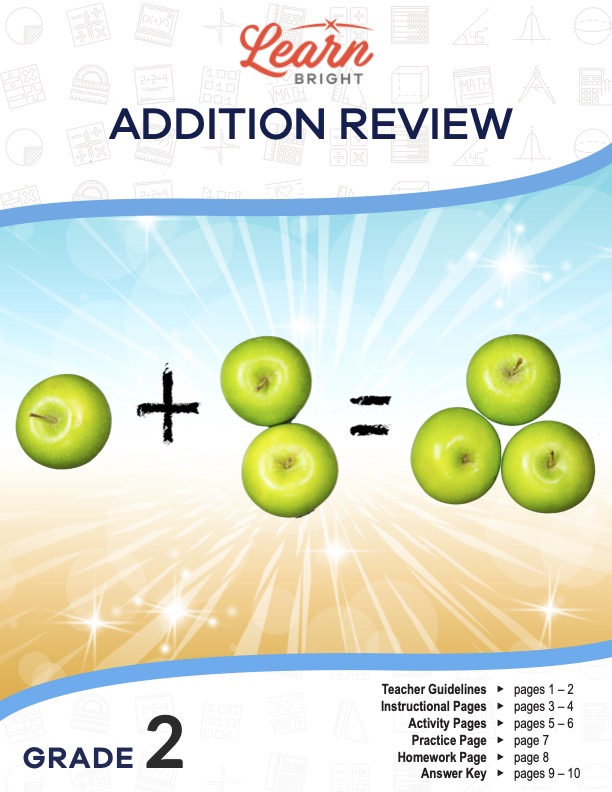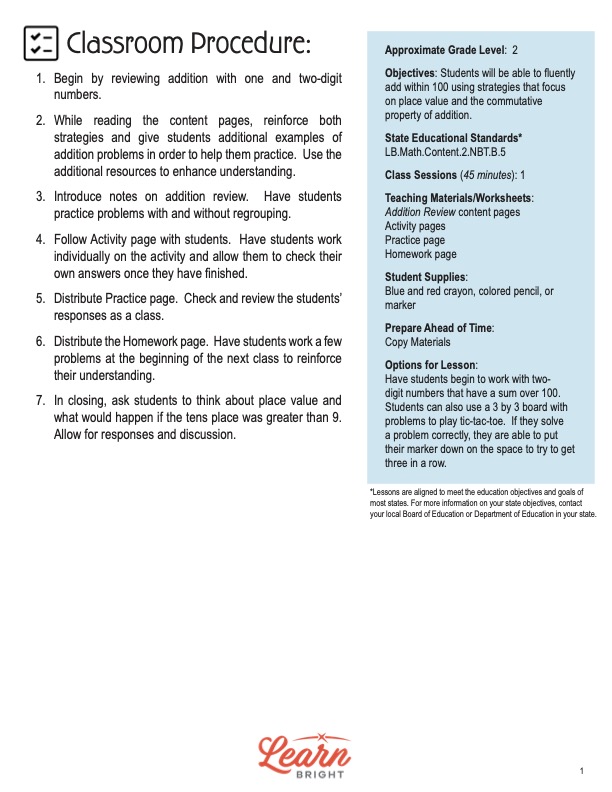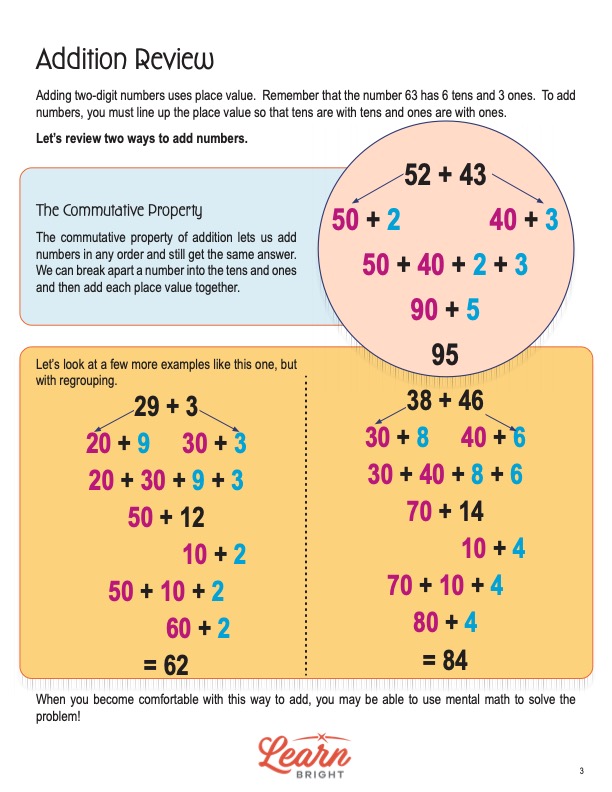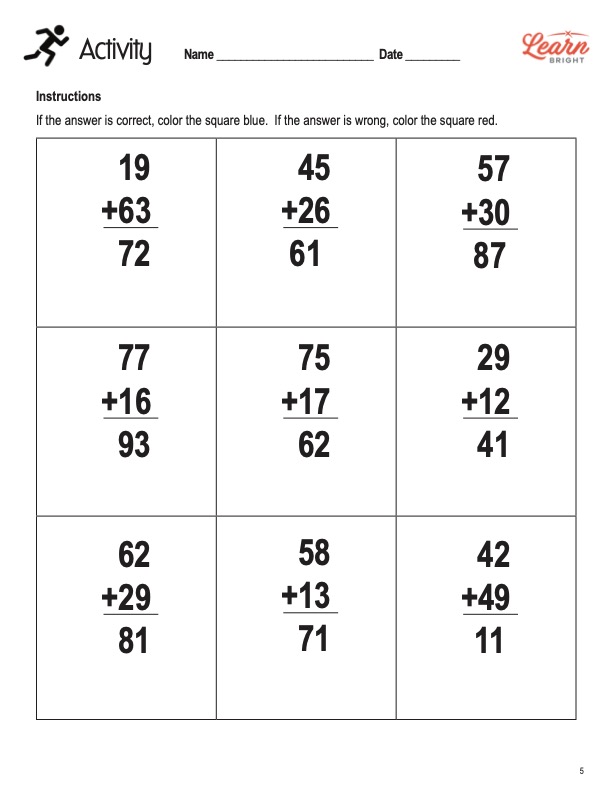Description
What our Addition Review lesson plan includes
Lesson Objectives and Overview: Addition Review is a great way to help students fluently add within 100. This lesson plan focuses on place value and the commutative property of addition, which are both essential concepts for students to master. With this lesson plan, students will be able to work with two-digit numbers that have a sum over 100. Additionally, they can use a 3 by 3 board with problems to play tic-tac-toe. This is a great way for students to get extra practice with addition while also having fun. This lesson is for students in 2nd grade.
Classroom Procedure
Every lesson plan provides you with a classroom procedure page that outlines a step-by-step guide to follow. You do not have to follow the guide exactly. The guide helps you organize the lesson and details when to hand out worksheets. It also lists information in the blue box that you might find useful. You will find the lesson objectives, state standards, and number of class sessions the lesson should take to complete in this area. In addition, it describes the supplies you will need as well as what and how you need to prepare beforehand. The only supplies you will need for this lesson are blue and red crayons, colored pencils, or markers. To prepare for this lesson ahead of time, you can gather the supplies and copy the handouts.
Options for Lesson
Included with this lesson is an “Options for Lesson” section that lists a number of suggestions for activities to add to the lesson or substitutions for the ones already in the lesson. One of the optional additions to this lesson is to have students start to work with two-digit numbers with sums above 100. You can also have your students use a 3 by 3 board with problems on it to play tic tac toe; if they get a problem right, they put their marker on that space. The first to three in a row wins!
Teacher Notes
The teacher notes page includes a paragraph with additional guidelines and things to think about as you begin to plan your lesson. It notes that the lesson reviews two different strategies for adding two-digit numbers, and that your students should therefore be familiar with addition before starting this lesson. This page also includes lines that you can use to add your own notes as you’re preparing for this lesson.
ADDITION REVIEW LESSON PLAN CONTENT PAGES
Addition Review
The Addition Review lesson plan includes two content pages. The lesson begins with an addition review. It states that we use place value to add two digit numbers. For example, the number 63 has 6 tens and 3 ones. To add this number to another number, we have to first line up the place values so that the tens are in line with the tens and the ones are in line with the ones. The lesson reviews two strategies for add numbers.
The first strategy is to use commutative property. This property of addition tells us that we can add numbers in any order and still get the same answer! This means that we can break a number apart into tens and once and then add each place value together to get the answer. The lesson includes a few examples. One example shows how you would add 52 and 43 together using this method. 52 becomes 50 + 2 and 43 becomes 40 + 3. If we add the tens and ones separately first, we add 50 + 40 and 2 +3 to get 90 + 5 = 95. The final sum is 95. The lesson also goes over two other examples using this method.
Regrouping
The second method that students can use for addition is regrouping. With this method, we line the numbers up vertically by place value and regroup. The lesson uses the same examples as above to illustrate this strategy. For the example problem of 52 + 43, we first add the ones place and then the tens. 2 + 3 = 5 and 5 + 4 = 9, so the final sum is 95. The lesson also shows the other two example problems to help solidify students’ understanding.
ADDITION REVIEW LESSON PLAN WORKSHEETS
The Addition Review lesson plan includes three worksheets: an activity worksheet, a practice worksheet, and a homework assignment. You can refer to the guide on the classroom procedure page to determine when to hand out each worksheet.
RIGHT OR WRONG ACTIVITY WORKSHEET
For the activity worksheet, students will look at nine addition problems. They will determine whether or not the answers provided for each problem are right or wrong. If the answer is correct, they will color that square blue. If the answer is incorrect, they will color that square red.
FIND THE SUMS PRACTICE WORKSHEET
The practice worksheet asks students to find the sums using the commutative property and place value. It also asks students to solve three addition problems using any method they’d like. They must show their work.
ADDITION REVIEW HOMEWORK ASSIGNMENT
For the homework assignment, students will complete two short exercises. The first asks them to find the sums using the commutative property and place value. The second asks them to solve addition problems using any method, showing their work.
Worksheet Answer Keys
This lesson plan includes answer keys for the practice worksheet and the homework assignment. If you choose to administer the lesson pages to your students via PDF, you will need to save a new file that omits these pages. Otherwise, you can simply print out the applicable pages and keep these as reference for yourself when grading assignments.









